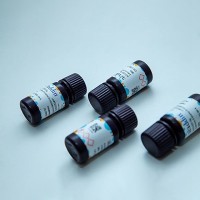The kinetic mechanisms of biological reactions are predominantly addressed by spectroscopic stopped-flow or temperature-jump methods. Both the stopped-flow and the temperature-jump methods are relaxation kinetic techniques, i.e., they rely on examining the effect of perturbation on the reaction system under study. The relaxation kinetic measurements of the approach to equilibrium of the ligand–macromolecule reactions provide two independent sets of data, relaxation times and amplitudes. Although the traditional matrix method is a powerful approach, the matrix projection operator technique is an exceptionally convenient approach to analyze stopped-flow kinetics. The numerical analysis of a complex multistep reaction is reduced to finding only the eigenvalues of the original coefficient matrix. The method is illustrated by examination of the kinetics of a fluorescent nucleotide analog binding to the E. coli replicative helicase, the DnaB protein.
Fluorescence intensity is one of the most often used spectroscopic signals to monitor the progress of biochemical reactions. Its properties also give an opportunity to address various structural aspects of the intermediates unavailable by any other method. The relative molar fluorescence intensities of different intermediates provide information about the physical environment surrounding the fluorophore during the course of the reaction. On the other hand, time-dependence of the fluorescence anisotropy in stopped-flow experiments provides information about the mobility of the fluorescing species in each intermediate of the observed kinetic process. Moreover, transient anisotropy data may also put additional light on the mechanism of the reaction, not obvious in studies using the emission intensity alone. Finally, collisional dynamic quenching of the fluorescence emission allows the experimenter to assess the solvent accessibility of the fluorophore. The method is mostly applied to steady-state fluorescence intensity in equilibrium. However, the same approach can be applied to address the solvent accessibility of the different intermediates, during the time course of the reaction monitored in the stopped-flow experiment.






